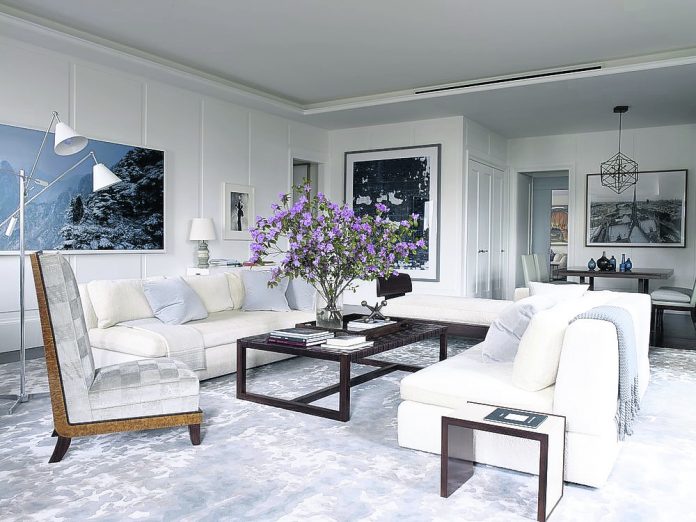An early, painted Swedish sideboard next to a leather sectional. An ornate Italian walnut headboard on a bed dressed in featherweight linen. A collection of colorful 1930s Fiestaware pottery on a Lucite bookshelf.
Mixing vintage and modern elements is one of the easier decorating techniques to employ. A little research can help with sourcing quality antiques, but combining old and new is mostly a matter of making sure the fun “found” pieces or family heirlooms get along with the contemporary components.
That introduction may take some tweaking so your room doesn’t end up looking like a catchall of random furniture, but that’s part of the fun. Introduce the furnishings to each other. See who gets along. And rearrange where everybody sits if you need to.
Tamara Rosenthal, Sotheby’s Home marketing vice-president, says the mix-and-match trend is on the rise.
“People aren’t as interested in spaces that look like they came entirely from a showroom,” she says. “They want to create a space with a unique point of view, infusing a variety of pieces, eras, textures and more to create a cohesive but unique look and feel.”
BALANCE IS KEY
Interior design maven Kimberley Seldon, whose business is based in Toronto and Los Angeles, follows this formula when mixing styles:
“As long as 80% of an interior is cohesive — same style, same period, same philosophy — the other 20% can deviate. In 20 years, I’ve never seen this rule of thumb fail.”
Rosenthal recommends layering old and new items, like hanging an antique rug in an otherwise modern room.
Elizabeth Sesser, a designer at the New York firm Ike Kligerman Barkley, mentions a recent project that blended vintage and modern furniture into an elegant whole. The new: a blue and gray wool and silk carpet, and creamy boucle sofas. The old: “Pairs of smaller, bolder pieces — 1920s Swedish black lacquer side chairs, and 1930s mahogany slipper chairs,” she says.
WATCH YOUR COMBINATIONS
Some vintage styles don’t complement each other as well as others, Seldon points out. For instance, the ornate embellishments and jewel tones of Victorian furnishings don’t work harmoniously with the Arts and Crafts movement, whose hallmarks are simpler craftsmanship and muted, nature-inspired hues.
If you do want to blend eras, consider Victorian with other formal European eras like Georgian, Edwardian and French. If you’ve got a few exceptional Arts and Crafts pieces, play them up with clean-lined country styles and modern upholstery.
“One of my favorite ways to mix design styles is with midcentury pieces,” says Rosenthal. “They’re truly transitional, because they can sway traditional or modern without looking out of place.”
Katie Watson-Smyth, who lives in London and writes the design blog Mad About the House, agrees about midcentury modern: “You will never go wrong with a chair from this period. It’s friends with everyone.”
She notes that midmod chairs can be re-upholstered in a range of fabrics to suit any design vibe.
She also recommends looking for common threads among your found pieces — rounded edges; wood and color tones; surface materials like marble.
NEW, INSPIRED BY OLD
If you don’t have true antiques, there are interesting new pieces that harken to the past.
For example, at this spring’s Architectural Digest Design Fair in New York, Brooklyn-based Rhyme Studio is debuting a collection of wool rugs inspired by a 1,600-year-old Irish alphabet, known as Ogham, or the tree alphabet. Its folk history may tie it to druids and secretive scholars, but the designs look as current and chic as anything dreamed up today.
And at Kathy Kuo, find an array of new seating, lighting and casegoods referencing popular eras like Hollywood Regency, French Country and Art Deco.
SHOP SMART
Rosenthal advises planning in advance before hunting for specific pieces, since the internet and antiques shops and fairs can be overwhelming. Be specific when you key in search terms. Knowing what you’re after helps, but be open to surprise finds.
“We always recommend starting with smaller items like mirrors, artwork, accessories and other accents,” she says.
“You can find a wide range of styles in mirrors in good shape that add a touch of history. And you can often find standout light fixtures that no one else will have,” she says.
“Shopping at a reputable site, antique dealer or well-regarded secondhand store is key,” she warns. “They’ll be able to provide all the information you need on the specific details of the piece.”
Pieces on the Sotheby’s Home site, for example, have been vetted by a team that assesses condition, authenticity, etc.
Besides Sotheby’s, check out the ever-changing lineup of furnishings and collectibles at Chairish, 1stDibs, Etsy, eBay, One King’s Lane and Jayson Home, where new pieces include a 19th century French wood and marble patisserie table, and a train bench salvaged from an old British colonial train in northern Thailand




















